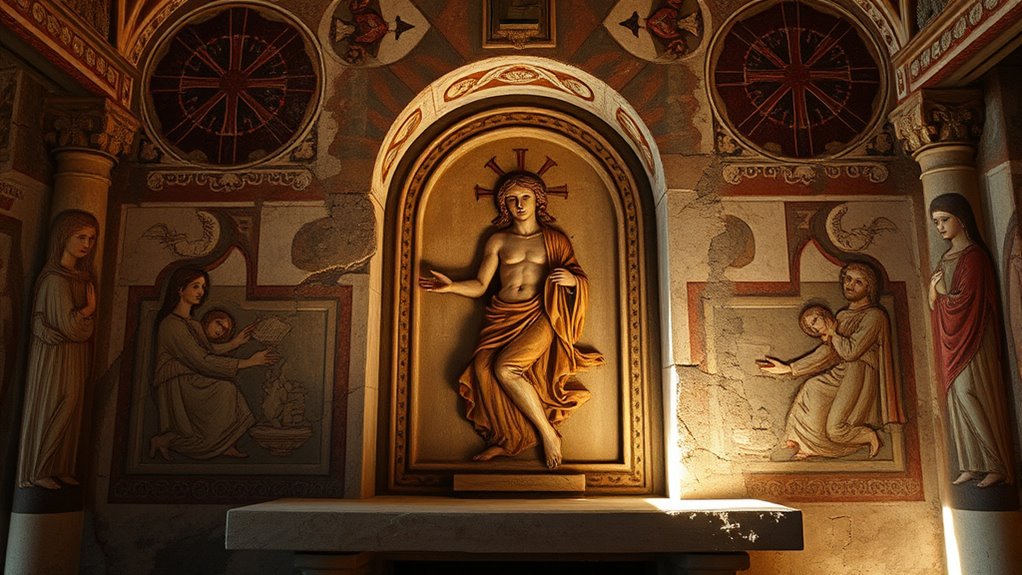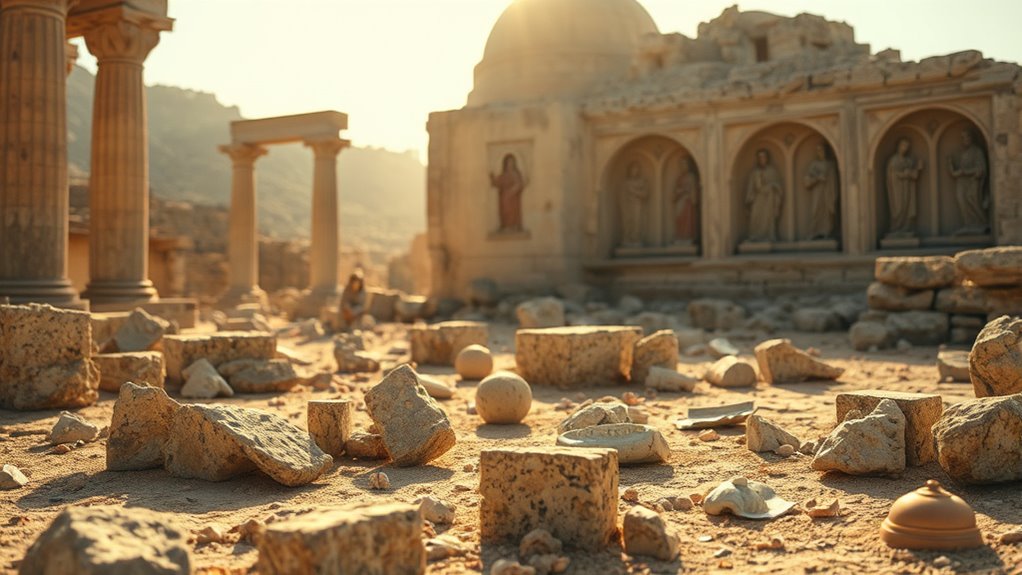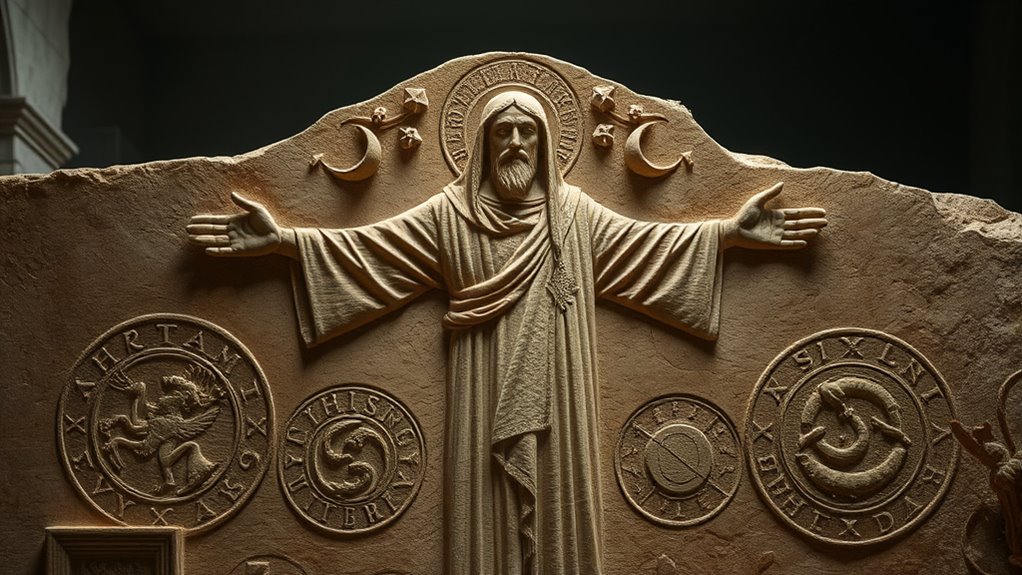Many experts note that stories of Jesus share similarities with pagan gods like Osiris and Mithras, involving themes like virgin birth and resurrection. These parallels suggest cultural exchanges or universal storytelling patterns rather than direct copying. Some believe myth influenced Christian narratives, blending religious ideas over time. However, historical evidence supports Jesus as a real figure, shaped by both tradition and historical events. To understand how myth and religion intertwine, explore further insights below.
Key Takeaways
- Similar motifs like virgin birth, death, and resurrection appear in both Jesus stories and pagan deities, suggesting cultural exchanges.
- Many parallels may reflect universal archetypes or mythic themes rather than direct copying.
- Historical evidence confirms Jesus as a real figure, indicating his story is rooted in actual events and religious development.
- Some scholars argue mythic elements in Jesus’ story were adapted from earlier pagan rituals and symbols.
- Others contend similarities are superficial, stemming from shared human storytelling patterns rather than intentional copying.
Comparing Mythological Narratives: Jesus and Ancient Deities

Many scholars compare the stories of Jesus to ancient mythological narratives, noting similarities in their themes and symbolism. This myth comparison reveals how stories of divine figures across cultures often share common motifs, such as death and resurrection, divine birth, or heroic journeys. These parallels suggest a process of religious syncretism, where different belief systems blend and influence one another over time. For instance, some see echoes of pagan deities like Osiris or Mithras in Jesus’ life story. This overlap might indicate that early Christian stories borrowed elements from existing mythologies to communicate spiritual truths or appeal to diverse audiences. The mythological motifs found in these narratives demonstrate how storytelling functions as a universal tool for conveying complex spiritual concepts across different cultures. Additionally, examining mythological parallels allows scholars to better understand how religious narratives evolve and adapt in response to cultural exchanges and historical contexts. Recognizing the importance of cultural exchange highlights how interconnected religious stories are and how they reflect shared human experiences. Furthermore, analyzing these similarities can shed light on how symbolic imagery plays a role in conveying profound religious messages. Exploring these similarities can also deepen our appreciation for the rich cultural diversity present in religious traditions worldwide. Understanding this myth comparison helps us see how religious narratives evolve and interact, shaping the rich tapestry of religious history across civilizations.
The Origins of Christian Stories in Pagan Traditions

The origins of Christian stories can often be traced back to earlier pagan traditions, which shared similar themes and symbols. These traditions utilized ritual symbolism to communicate spiritual truths and foster community bonds. You’ll notice that myths spread through myth dissemination, allowing ideas to evolve across cultures. Key similarities include:
Many Christian stories echo ancient pagan symbols and rituals.
- Symbols of rebirth, like dying and rising gods
- Rituals mimicking agricultural cycles and fertility rites
- Stories of divine figures born from miraculous circumstances
Historical Evidence for Jesus as a Real Person

While pagan traditions share common themes with early Christian stories, historical evidence provides a different kind of insight—one grounded in documented sources. Multiple ancient writings mention Jesus outside of Christian texts, including Roman and Jewish historians like Tacitus and Josephus. These references confirm he was a real person who lived in Judea during the first century. This evidence challenges the idea of myth creation as the sole origin of Jesus’ story. Instead, it suggests that religious symbolism and historical events shaped his life and teachings. By examining these sources, you see that Jesus’ existence isn’t just a product of myth, but a figure rooted in historical context, making his existence more credible beyond religious narratives.
Similarities Between Jesus and Pagan Gods: What Do They Mean?

Have you ever wondered why stories of Jesus share similarities with pagan gods from different cultures? These parallels often involve symbolic symbolism and ritual parallels, suggesting shared themes across religions. For example, many pagan gods are said to be born of virgins, die and rise again, or be associated with water Baptism-like rituals. These commonalities could indicate cultural exchanges or universal archetypes rather than direct copying. To understand this better, consider:
- The motif of death and resurrection found in multiple mythologies
- Rituals involving water or rebirth that resemble Christian practices
- Symbolic symbolism emphasizing divine sacrifice and renewal
- The persistence of archetypal themes across diverse religious traditions
Additionally, some scholars argue that these similarities reflect mythological patterns that arise naturally from human storytelling and cultural evolution. Recognizing shared motifs can help us appreciate how human cultures develop complex narratives that address universal questions about life, death, and renewal. For instance, the recurring theme of divine suffering demonstrates a universal human experience that transcends specific religious contexts. These similarities raise questions about their meanings, whether as intentional borrowing or as expressions of universal human themes. For example, the recurrence of divine suffering in myths highlights a common understanding of sacrifice and redemption. They don’t necessarily prove copying but highlight shared symbolic motifs across religious traditions.
Scholarly Perspectives on the Borrowing Hypothesis

Scholars have long debated whether the similarities between Jesus and pagan gods result from direct borrowing or reflect shared human themes. Those supporting the borrowing hypothesis argue that myth construction often involves adapting popular pagan stories into new religious contexts, which could explain the parallels. They suggest that cultural exchange and syncretism influenced early Christian narratives, raising theological implications about originality and divine authority. Critics, however, contend that these similarities are superficial and stem from common archetypes rather than direct copying. From this vantage point, shared human themes—like sacrifice, resurrection, or divine birth—are universal motifs that transcend specific mythologies. Additionally, mythological motifs are frequently shared across cultures, making it challenging to determine whether similarities indicate borrowing or parallel development. Some scholars also note that the universal nature of religious narratives reflects shared human experiences, which naturally produce recurring patterns and themes. The cross-cultural similarities may also result from the innate human tendency to seek meaning through storytelling. Furthermore, the role of creative practice in shaping mythologies suggests that similar stories could arise independently as part of universal human expression. In this context, the influence of cultural exchange on religious stories is also a significant factor, complicating efforts to establish direct copying. Overall, these scholarly debates highlight the complex nature of myth construction and its impact on understanding religious development and theological interpretations.
Evaluating the Impact of Mythology on Religious Development

Mythology has played a significant role in shaping religious development by providing a framework of symbolic stories that convey moral values, cosmological understanding, and divine authority. These stories, rooted in myth and religion, influence how communities view the universe and their place within it. Through historical mythmaking, societies craft narratives that justify traditions and beliefs, often blending mythic elements with evolving religious ideas. Understanding the role of myth helps clarify how religious narratives evolve and influence societal values. Additionally, examining historical data reveals patterns and developments that have shaped religious mythologies over time. The integration of myth into religious systems often results in cultural continuity, reinforcing shared identities and morals across generations. Myth serves as a foundation for rituals and practices. Religious leaders use myth to legitimize authority. Mythology helps explain natural phenomena and life’s mysteries.
Understanding this impact reveals how myth and religion intertwine, shaping faith and cultural identity over centuries. The influence of mythology on religious development remains a powerful force in molding spiritual beliefs.
Frequently Asked Questions
How Do Cultural Contexts Influence Myth Similarities Across Religions?
You see, cultural contexts shape myth similarities because cultural exchange and religious syncretism blend stories across societies. When cultures interact, they share symbols and narratives, leading to common themes. This process influences religious myths, making them appear similar even if developed independently. So, understanding cultural exchange helps explain why different religions often have comparable stories, highlighting how mythologies evolve through shared influences rather than direct copying.
Are There Any Archaeological Discoveries Confirming Jesus’s Historical Existence?
You might wonder if archaeological discoveries confirm Jesus’s existence. While there’s no direct ancient inscription explicitly naming Jesus, historical artifacts like the James Ossuary and references from early historians such as Josephus and Tacitus support his historical presence. These findings, combined with biblical accounts, suggest Jesus was a real person, even if some details remain debated among scholars.
What Role Do Oral Traditions Play in Shaping Religious Stories?
You see, oral storytelling plays a crucial role in shaping religious stories, as it allows traditions to evolve over time. Through tradition evolution, stories are passed down, adapted, and enriched with each generation. This oral tradition keeps religious narratives alive, giving them deeper meaning and cultural relevance. As you explore these stories, remember that their development often reflects community values and shared beliefs, making oral storytelling a vital part of religious history.
How Do Different Denominations Interpret the Origins of Jesus’s Narrative?
Did you know that over 30 Christian denominations interpret Jesus’s origins differently? In historical debates, some see his story as rooted in real events, while others view it through theological perspectives, considering myth or allegory. You might find that these varied beliefs influence practices and teachings, shaping your understanding of Jesus’s life. Each denomination’s view reflects their unique approach to faith, history, and tradition.
Can Myth Borrowing Explain the Development of Religious Doctrines?
You might wonder if myth borrowing explains doctrinal development. Myth origins often influence religious narratives, shaping doctrines over time. When cultures share stories, they adapt and integrate elements, leading to evolving beliefs. This process helps explain how doctrines grow richer and more complex. So, yes, myth origins can profoundly impact doctrinal development, as traditions absorb and reinterpret stories from different mythologies, creating new religious understandings.
Conclusion
As you consider the parallels between Jesus and pagan gods, it’s like watching shadows dance on a cave wall—familiar shapes that spark questions. While stories may share threads, your journey reveals a tapestry woven with history and faith. Whether myth or reality, this contrast invites you to see beyond the surface, recognizing that faith’s true power lies in the meaning you find within, rather than the origins that lie behind it.










